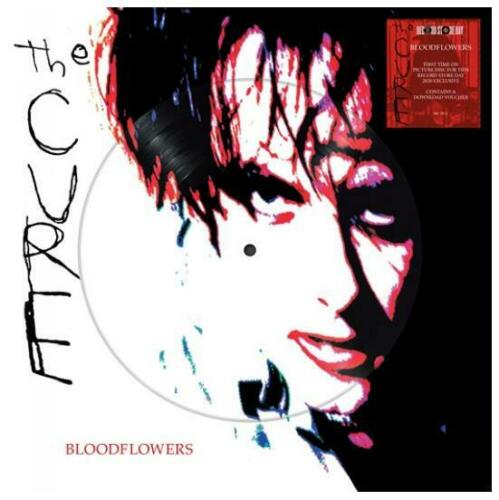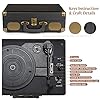The Cure Vinyl Records Lps For Sale
Check out these new and used The Cure vinyl records LPs for sale. We recommend starting your The Cure vinyl collection with the essential albums Kiss Me Kiss Me Kiss Me, Faith and Wish. Our inventory is always changing, so check back often, or browse our list of vinyl records for sale from rock musicians.

The Cure: A Journey Through Sonic Landscapes
The Birth of The Cure (1978-1980)
Formation and Early Lineup Changes The Cure, an iconic post-punk and alternative rock band, was formed in Crawley, West Sussex, England, in 1978. The initial lineup included Robert Smith (vocals, guitar), Michael Dempsey (bass), Lol Tolhurst (drums), and Matthieu Hartley (keyboards). Their early sound was characterized by a blend of post-punk and gothic influences.
“Three Imaginary Boys” (1979) The band’s debut album, “Three Imaginary Boys” (1979), showcased a raw and minimalist sound. Tracks like “10:15 Saturday Night” and “Grinding Halt” introduced listeners to Robert Smith’s distinctive voice and the band’s unique approach to songwriting.
Transition to Darker Tones with “Seventeen Seconds” (1980) The Cure’s second album, “Seventeen Seconds” (1980), marked a transition to darker and atmospheric tones. Tracks such as “A Forest” and “Play for Today” established the band’s signature sound, characterized by haunting melodies and Smith’s introspective lyrics.
Defining the Gothic Sound (1981-1982)
“Faith” (1981) and Introspective Exploration “Faith” (1981) delved deeper into introspective and existential themes. The album’s title track and “The Drowning Man” exemplified The Cure’s ability to create atmospheric and emotionally charged music. The minimalist arrangements contributed to the overall sense of melancholy.
“Charlotte Sometimes” EP (1981) The EP “Charlotte Sometimes” (1981) further explored the band’s gothic tendencies. The title track, in particular, showcased a dreamlike quality, foreshadowing The Cure’s later ventures into more ethereal and experimental realms.
“Pornography” (1982) and Sonic Intensity “Pornography” (1982) marked the culmination of The Cure’s early gothic phase. The album’s sonic intensity and bleak atmosphere were epitomized by tracks like “One Hundred Years” and “The Hanging Garden.” Smith’s lyrics delved into themes of existential angst and inner turmoil.
Pop Sensibility Emerges (1983-1985)
Introduction of Simon Gallup and “Japanese Whispers” (1983) Bassist Simon Gallup officially joined the band in 1982, solidifying a lineup that would become iconic. The compilation album “Japanese Whispers” (1983) showcased a shift towards a more accessible and pop-oriented sound. Hits like “Let’s Go to Bed” and “The Walk” displayed a newfound playfulness.
“The Top” (1984) and Eclectic Influences “The Top” (1984) demonstrated The Cure’s willingness to experiment with various musical styles. The album incorporated elements of psychedelia, world music, and alternative rock. Tracks like “Shake Dog Shake” and “The Caterpillar” highlighted the band’s eclectic influences.
“The Head on the Door” (1985) and Mainstream Success “The Head on the Door” (1985) marked a pivotal moment for The Cure. The album’s diverse sound, ranging from the upbeat “Close to Me” to the melancholic “A Night Like This,” garnered mainstream success. The band’s ability to balance accessibility with artistic depth set the stage for their future endeavors.
Synth-Pop Exploration (1986-1987)
“Standing on a Beach” (1986) – Singles Compilation The compilation album “Standing on a Beach” (1986) featured hit singles from The Cure’s earlier years. The release of the accompanying videos contributed to the band’s visual identity. This compilation served as a retrospective, showcasing the evolution of The Cure’s sound.
“Kiss Me, Kiss Me, Kiss Me” (1987) and Genre Fusion “Kiss Me, Kiss Me, Kiss Me” (1987) was a sprawling double album that embraced a fusion of genres. From the pop-infused “Just Like Heaven” to the psychedelic “The Kiss,” the album showcased The Cure’s musical versatility. It became a commercial success and solidified the band’s position as alternative rock pioneers.
Darker Shades Return (1989-1992)
“Disintegration” (1989) – Epic Masterpiece “Disintegration” (1989) stands as one of The Cure’s masterpieces. The album delved back into darker and more atmospheric tones. Epic tracks like “Pictures of You” and “Lovesong” showcased the band’s ability to create emotionally resonant and immersive sonic landscapes.
“Entreat” (1990) – Live Reflection of “Disintegration” “Entreat” (1990) was a live album featuring performances of songs from “Disintegration.” The album captured the intensity and emotional depth of The Cure’s live performances, providing a powerful complement to the studio versions.
“Mixed Up” (1990) – Remix Compilation “Mixed Up” (1990) featured remixes of some of The Cure’s classic tracks. The album demonstrated the band’s openness to reinterpretation and experimentation with their own material.
“Wish” (1992) – Grammy Success “Wish” (1992) continued The Cure’s exploration of atmospheric and melodic soundscapes. The album earned the band critical acclaim and Grammy success, with the single “Friday I’m in Love” becoming a mainstream hit.
Experimental Phases (1996-2008)
“Wild Mood Swings” (1996) – Eclectic Sound Palette “Wild Mood Swings” (1996) embraced an eclectic sound palette, featuring everything from orchestral arrangements to electronic elements. The album showcased The Cure’s willingness to push boundaries and defy genre conventions.
“Bloodflowers” (2000) – Trilogy Conclusion “Bloodflowers” (2000) marked the conclusion of The Cure’s trilogy of albums that began with “Pornography” and continued with “Disintegration.” The album revisited the darker themes of its predecessors and received critical acclaim for its emotional depth.
“The Cure” (2004) – Return to Pop Sensibility “The Cure” (2004) saw the band returning to a more straightforward and pop-oriented sound. The album featured radio-friendly tracks like “The End of the World” and “Taking Off.”
“4:13 Dream” (2008) – Guitar-Driven Resurgence “4:13 Dream” (2008) showcased a resurgence of the band’s guitar-driven sound. Tracks like “The Only One” and “Freakshow” featured infectious melodies and demonstrated The Cure’s enduring ability to craft memorable pop-rock tunes.
Ongoing Legacy and Live Performances (2008-Present)
Global Tours and Festivals The Cure has maintained a consistent presence on the global stage through extensive touring and festival performances. Their live shows are celebrated for their atmospheric quality, featuring a mix of hits and deep cuts that span their extensive catalog.
“Seventeen Seconds” to “Bloodflowers” Tour (2016) In 2016, The Cure embarked on a tour that spanned their albums from “Seventeen Seconds” to “Bloodflowers,” providing fans with a comprehensive retrospective of their gothic and atmospheric phases.
Rock and Roll Hall of Fame Induction (2019) In 2019, The Cure was inducted into the Rock and Roll Hall of Fame, recognizing their significant contributions to the alternative rock genre and their enduring influence on subsequent generations of musicians.
Upcoming Projects and Legacy
The Cure’s legacy is one of artistic evolution, sonic experimentation, and a commitment to emotional depth. As of my last knowledge update in January 2022, The Cure’s future plans and potential new releases were not specified. However, given their history of pushing musical boundaries, fans eagerly anticipate any new projects that may emerge.
Discography Overview
1. “Three Imaginary Boys” (1979)
- Debut album with minimalist post-punk sound.
2. “Seventeen Seconds” (1980)
- Transition to a darker and atmospheric sonic landscape.
3. “Faith” (1981)
- Deepening introspection with a minimalist approach.
4. “Pornography” (1982)
- Culmination of early gothic phase with intense themes.
5. “Japanese Whispers” (1983)
- Compilation showcasing a shift to a more pop-oriented sound.
6. “The Top” (1984)
- Eclectic experimentation with various musical styles.
7. “The Head on the Door” (1985)
- Mainstream success with a diverse and accessible sound.
8. “Kiss Me, Kiss Me, Kiss Me” (1987)
- Fusion of genres with a sprawling and ambitious double album.
9. “Disintegration” (1989)
- Epic masterpiece exploring darker emotional themes.
10. “Wish” (1992) – Grammy-winning album with a mix of atmospheric and melodic tracks.
11. “Wild Mood Swings” (1996) – Eclectic sound palette showcasing experimentation.
12. “Bloodflowers” (2000) – Conclusion of the trilogy with a return to darker themes.
13. “The Cure” (2004) – Return to pop sensibility with radio-friendly tracks.
14. “4:13 Dream” (2008) – Guitar-driven resurgence with infectious melodies.
Conclusion
The Cure’s journey through sonic landscapes spans over four decades, marked by musical innovation, emotional depth, and an unwavering commitment to artistic integrity. From their early post-punk and gothic roots to their exploration of pop, alternative rock, and experimental phases, The Cure has left an indelible mark on the music landscape. Their ability to evolve while maintaining a distinct sonic identity has garnered a diverse and dedicated fanbase, solidifying their place as one of the most influential bands in alternative rock history.




![Mixes Of A Lost World[180g BioVinyl 2 LP] [Half-Speed] #1](https://m.media-amazon.com/images/I/51I8Ymc4xJL._SL100_.jpg)
![Mixes Of A Lost World[180g BioVinyl 2 LP] [Half-Speed] #2](https://m.media-amazon.com/images/I/41xhl8kkvTL._SL100_.jpg)


















![GNX[LP] #1](https://m.media-amazon.com/images/I/51EXnBFIdPL._SL100_.jpg)

![Back to Black [Vinyl] #1](https://m.media-amazon.com/images/I/61Db7-hQGKL._SL100_.jpg)


![Gold - Greatest Hits[2 LP] #1](https://m.media-amazon.com/images/I/51mGW9UohWL._SL100_.jpg)
![Gold - Greatest Hits[2 LP] #2](https://m.media-amazon.com/images/I/410sx7AtHuL._SL100_.jpg)
![Gold - Greatest Hits[2 LP] #3](https://m.media-amazon.com/images/I/41PywevsgbL._SL100_.jpg)





![[Exquisite Appearance] Built from wood and metal materials with a unique sense of layering; The streamlined corner design is truly atmospheric and stylish(Note: long hold the start button to turn the power on, and press again to start) [All in 1] Thi...](https://m.media-amazon.com/images/I/41vovGjFkeL._SL160_.jpg)






































